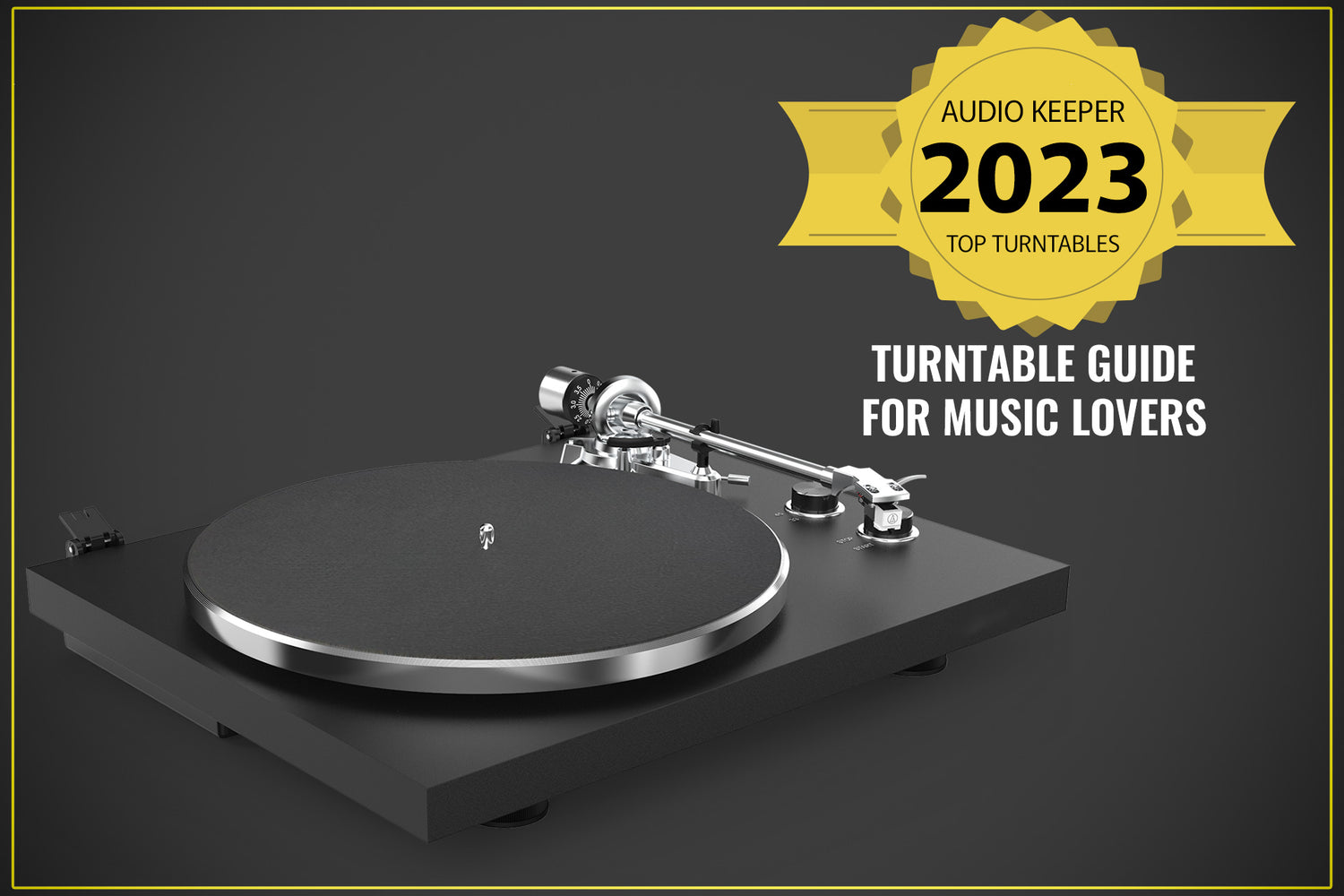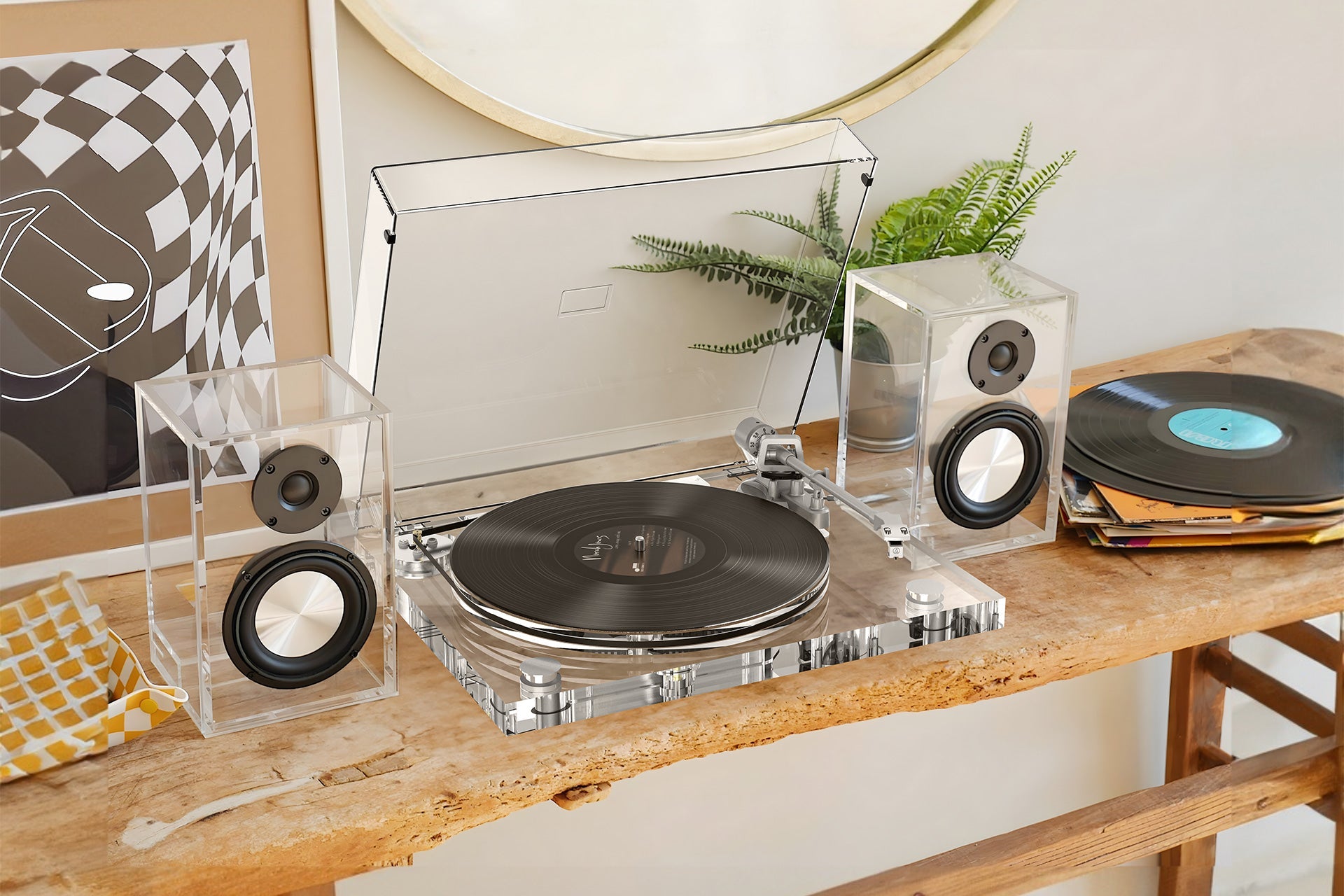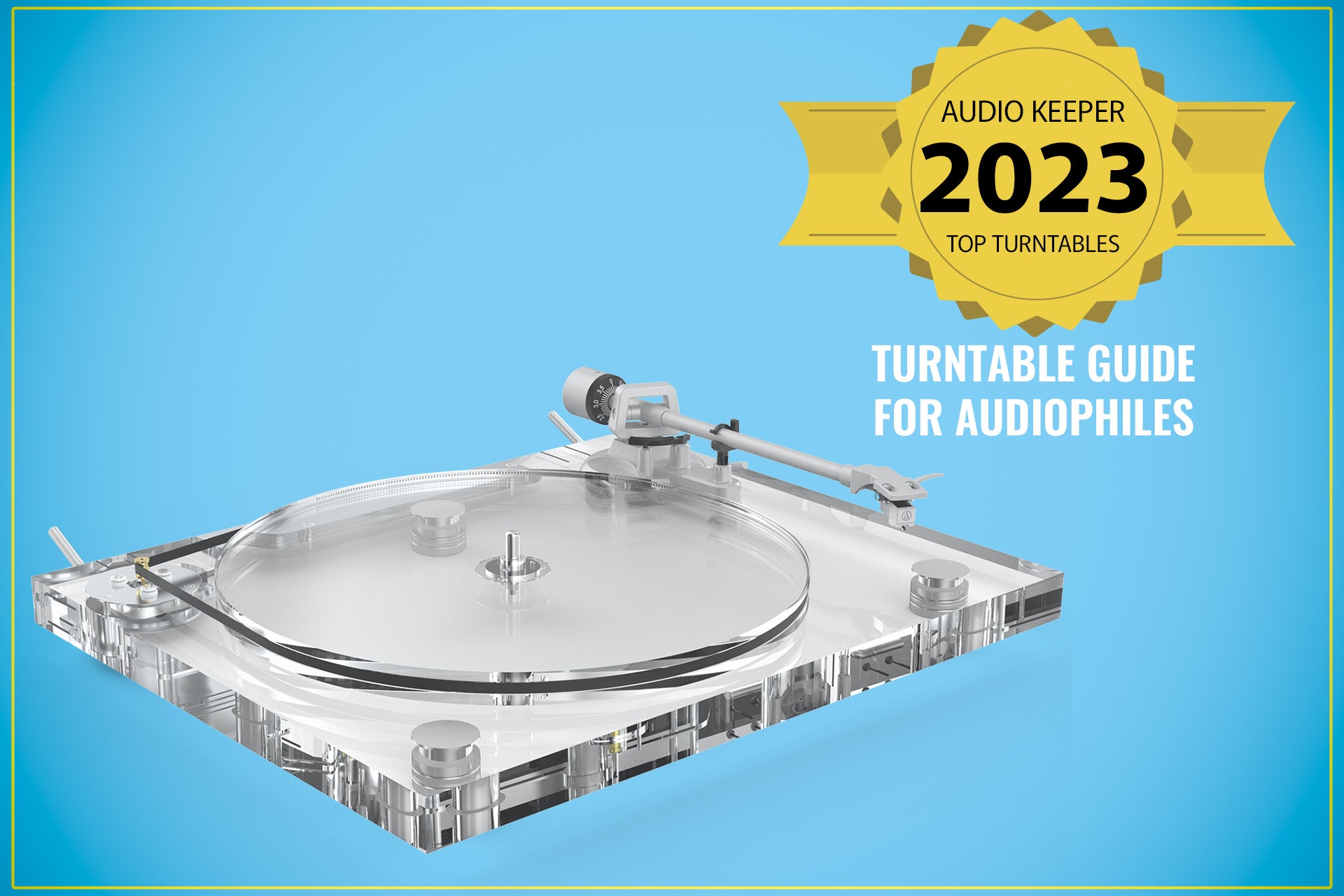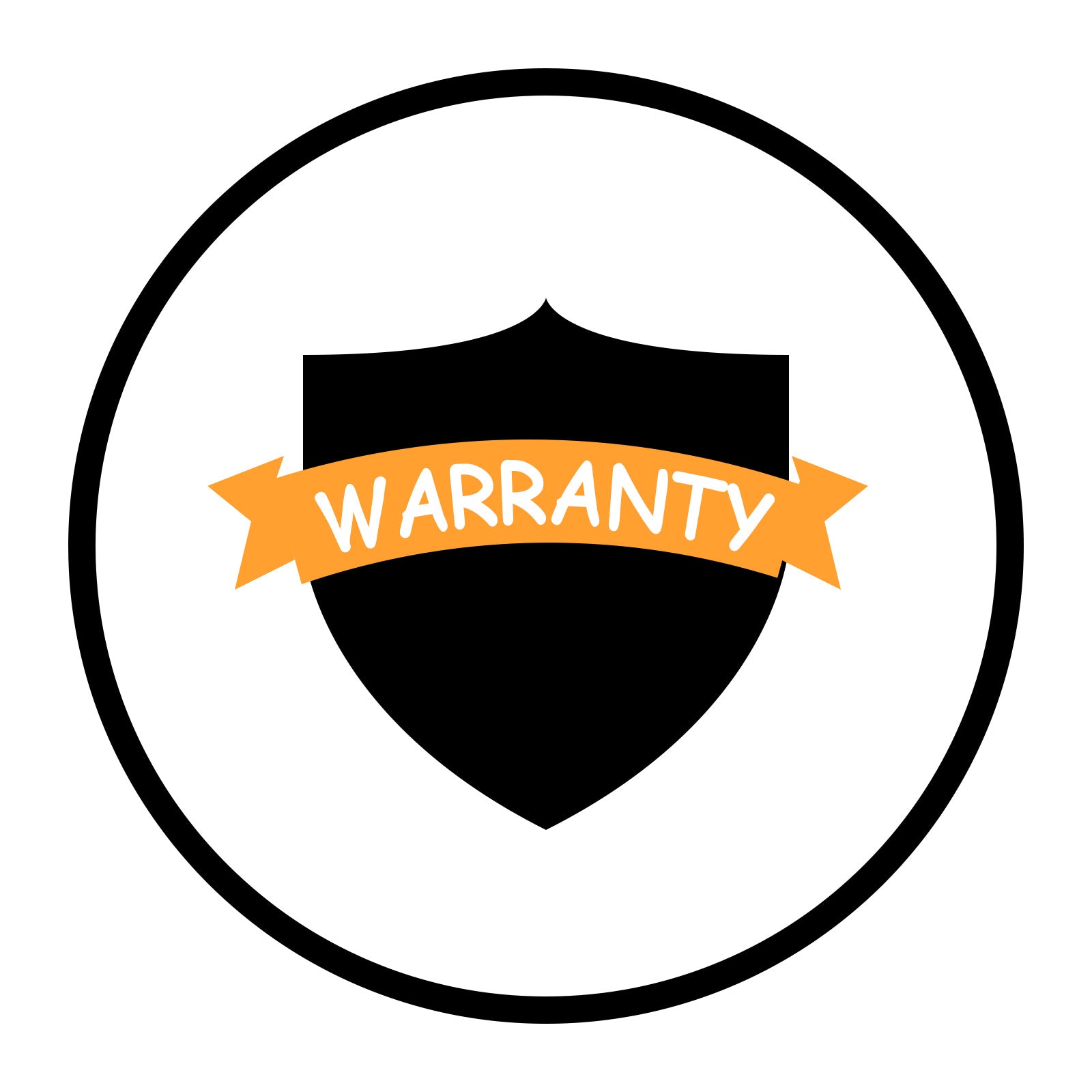Introduction:
Welcome to the world of high-fidelity audio! As a brand dedicated to crafting and delivering premium turntables, turntable audio systems, and accessories, we understand the importance of making informed choices when it comes to your audio equipment. In this extensive guide, we will walk you through the essential aspects of selecting the perfect turntable setup, ensuring that your musical journey is nothing short of extraordinary.
Section 1: Understanding the Basics of Turntables
Embarking on the journey into the world of turntables requires a fundamental understanding of their key components. In this section, we will unravel the basics of turntables, shedding light on the core elements that shape their performance and contribute to the rich, analog sound that music enthusiasts cherish.
-
Plinth: The Foundation of Elegance
The plinth, or base, serves as the foundation of the turntable. It provides stability and minimizes vibrations that could affect the delicate process of reading vinyl grooves. Materials like MDF, acrylic, or wood are commonly used, each contributing its unique sonic characteristics.
-
Tonearm: The Navigator of Sound
The tonearm is the mechanical arm responsible for supporting the cartridge and stylus as it glides across the record. It must be precisely balanced to ensure accurate tracking, and materials like carbon fiber or aluminum are often employed for their balance of rigidity and weight.
-
Cartridge: Capturing Musical Nuances
At the end of the tonearm rests the cartridge, a critical component that houses the stylus responsible for tracing the grooves on the vinyl. Moving Magnet (MM) and Moving Coil (MC) are the two primary types of cartridges, each offering distinct sonic characteristics that cater to different preferences.
-
Stylus: Navigating the Grooves
The stylus is the needle-like component that directly contacts the record's grooves, translating the physical vibrations into electrical signals. Stylus shapes vary, with elliptical, conical, and microline being common. The shape influences tracking ability and overall sound quality.
-
Drive Systems: Powering the Spin
Turntables can feature different drive systems: belt-drive or direct-drive. Belt-drive turntables use an elastic belt to transfer motor power to the platter, reducing vibrations. Direct-drive turntables have the motor directly connected to the platter, offering stability and precise speed control.
-
Platter: Where the Magic Happens
The platter is the spinning surface upon which the vinyl record rests. Materials like acrylic or aluminum are chosen for their inert qualities, minimizing resonance and interference with the delicate playback process.
Understanding these basic components provides a solid foundation for selecting a turntable that aligns with your preferences and listening environment. As we delve deeper into the world of turntables, these fundamentals will guide you in making informed choices for an enriched musical experience.
Section 2: Exploring Turntable Types and Features
As you venture into the realm of turntables, it becomes evident that these analog marvels come in various types, each catering to different preferences and needs. In this section, we'll embark on a journey to explore the diverse world of turntable types and the features that make each one unique.
-
Manual vs. Automatic Turntables:
-
Manual Turntables: These require the user to lift the tonearm and place it on the record manually. Manual control provides a hands-on, immersive experience, allowing users to interact more intimately with the vinyl.
-
Automatic Turntables: Designed for convenience, automatic turntables can lift the tonearm, place it on the record, and return it to the rest automatically. Ideal for those seeking a hassle-free experience, especially for continuous listening.
-
-
Direct-Drive vs. Belt-Drive Systems:
-
Direct-Drive Systems: Direct-drive turntables have the motor directly connected to the platter, ensuring a consistent and accurate rotation speed. This design is favored by DJs for its quick start and stop capabilities.
-
Belt-Drive Systems: In belt-drive turntables, a belt connects the motor to the platter. This setup minimizes motor vibrations, resulting in less interference with the stylus. Belt-driven turntables are often preferred by audiophiles for their potential sonic benefits.
-
-
Built-In Preamps and USB Connectivity:
-
Built-In Preamps: Some turntables come with built-in preamplifiers, allowing direct connection to speakers or amplifiers without the need for an external preamp. This feature simplifies the setup for those looking for a plug-and-play solution.
-
USB Connectivity: Modern turntables may include USB ports for connecting to computers. This feature facilitates the digitization of vinyl records, enabling users to convert their analog treasures into digital formats.
-
-
Adjustable Speeds:
- Turntables typically offer two standard speeds: 33 1/3 and 45 RPM. Some models, however, provide additional speeds like 78 RPM, accommodating a broader range of vinyl records.
-
Isolation and Vibration Control:
-
Isolation Platforms: To minimize vibrations and resonance, some turntables feature isolation platforms or feet. These components enhance stability and contribute to improved audio performance.
-
Suspension Systems: High-end turntables may incorporate sophisticated suspension systems that isolate the platter and tonearm from external vibrations, ensuring a pure and undisturbed playback experience.
-
-
Cueing Mechanism:
- The cueing mechanism allows users to raise and lower the tonearm with precision. Some turntables feature hydraulic cueing, providing a smooth and controlled descent onto the record.
Understanding these turntable types and features empowers you to choose a model that aligns with your preferences, whether you seek hands-on control, convenience, or specific technical capabilities. As we continue this exploration, you'll gain deeper insights into crafting your ideal turntable setup.
Section 3: Navigating the World of Cartridges and Styluses
Section 4: Turntable Accessories: Elevating Your Listening Experience
In the pursuit of audio excellence, turntable accessories play a pivotal role in refining the nuances of your listening experience. From isolation platforms to record cleaning kits, this section will guide you through the essential accessories that elevate the performance of your turntable and preserve the integrity of your vinyl collection.
-
Isolation Platforms:
- Purpose: Isolation platforms mitigate vibrations, providing a stable surface for your turntable.
- Materials: Commonly made from materials like wood, acrylic, or specialized polymers.
- Benefits: Improved soundstage, reduced interference, and enhanced clarity in audio reproduction.
-
Record Mats:
- Purpose: Placed between the record and the turntable platter, record mats influence the coupling of the stylus to the vinyl.
- Materials: Options include cork, felt, rubber, and even leather.
- Benefits: Can affect sound characteristics, reduce static, and provide additional damping.
-
Record Cleaning Kits:
- Purpose: Keeping your vinyl collection clean is essential for optimal playback and longevity.
- Components: Typically include a cleaning solution, brush or cleaning pad, and sometimes a stylus brush.
- Benefits: Minimizes surface noise, removes dust and debris, and enhances overall audio fidelity.
-
Clamps and Weights:
- Purpose: Improve vinyl contact with the turntable platter, reducing resonance and enhancing stability.
- Types: Record clamps and weights come in various designs, from simple clamps to heavy metal weights.
- Benefits: Tighter bass response, improved transient response, and a more controlled sound.
-
Tonearm Lifter:
- Purpose: Provides a gentle lift for the tonearm at the end of a record, preventing unnecessary wear on the stylus and record.
- Manual vs. Automatic: Available in both manual and automatic configurations.
- Benefits: Prolongs stylus and record life, automates the tonearm lifting process.
-
Bubble Level:
- Purpose: Ensures the turntable is perfectly leveled, optimizing playback performance.
- Placement: Placed on the turntable plinth for easy leveling adjustments.
- Benefits: Improves tracking accuracy and prevents uneven wear on the stylus.
-
Storage Solutions:
- Purpose: Proper storage is crucial for preserving the condition of your vinyl records.
- Options: Record crates, shelves, and dedicated storage furniture.
- Benefits: Protects records from dust, warping, and damage.
-
Headshell and Cartridge Screws:
- Purpose: Securely fasten the cartridge to the tonearm headshell.
- Materials: Typically made of lightweight but durable materials.
- Benefits: Ensures proper alignment and stability for accurate tracking.
Each of these accessories contributes to the holistic improvement of your turntable setup. As you carefully choose and integrate these elements, you enhance not only the performance of your turntable but also the overall pleasure derived from your vinyl collection. In the next sections, we'll further explore the nuances of fine-tuning your turntable for an unparalleled audio journey.
Section 5: The Intersection of Design and Functionality
In the world of turntables, the marriage of design and functionality is where aesthetics meet sonic performance. This section delves into how the visual appeal of turntables aligns with their technical features, creating a harmonious balance that enhances both the auditory and visual aspects of your listening experience.
-
Plinth Designs:
-
Wooden Elegance: Wooden plinths exude classic charm and warmth, often chosen for their aesthetic appeal. Different wood types can impart varying sonic characteristics to the overall sound.
-
Modern Minimalism: Acrylic and metal plinths are favored for their sleek, contemporary aesthetics. These materials also contribute to a cleaner sound profile by minimizing resonance.
-
Personalized Touch: Some turntables offer customizable plinths, allowing users to choose finishes, colors, and materials to match their individual style preferences.
-
-
Tonearm Aesthetics:
-
Sleek and Streamlined: Modern tonearms often feature sleek designs with minimalistic shapes, contributing to an overall uncluttered appearance.
-
Vintage Vibes: Some turntables embrace a retro aesthetic with tonearms reminiscent of classic designs, appealing to those who appreciate a vintage look.
-
-
Platter Styling:
-
Transparency and Light: Acrylic platters provide a visually striking element, especially when coupled with integrated lighting. This feature adds a touch of modernity to the turntable.
-
Metallic Elegance: Metal platters, often made of aluminum, can convey a sense of durability and high-end craftsmanship. Their reflective surfaces add a touch of sophistication.
-
-
Decoupling and Isolation Elements:
-
Subtle Integration: Turntables designed for enhanced isolation may incorporate isolation feet or suspension systems. These elements are often integrated seamlessly into the overall design.
-
Visible Innovation: Some turntables proudly display their isolation mechanisms, turning them into design features that highlight the commitment to sonic purity.
-
-
Control Elements:
-
Intuitive Controls: The arrangement of buttons, switches, and knobs is a crucial aspect of turntable design. Intuitive layouts enhance user experience, allowing for effortless operation.
-
Digital Displays: Modern turntables may feature digital displays for accurate speed readouts and other performance metrics, blending technological functionality with visual appeal.
-
-
Customization Options:
-
Interchangeable Parts: Turntables that offer interchangeable components, such as customizable headshells or tonearm wands, empower users to tailor the appearance to their liking.
-
Personalized Accents: Some manufacturers provide options for personalized accents, allowing users to add a touch of individuality to their turntable's appearance.
-
-
Overall Aesthetic Cohesion:
- Branding and Identity: Manufacturers often infuse their design language into turntables, creating a visual identity that extends beyond functionality. Recognizable branding elements contribute to a cohesive aesthetic.
In the world of turntables, where the auditory experience is paramount, the visual appeal should not be underestimated. The intersection of design and functionality results in turntables that are not just audio devices but also pieces of functional art that enhance your listening space. As we move forward, we will delve into the critical aspects of fine-tuning your sound system for optimal performance.
Section 6: Fine-Tuning Your Sound: The Role of Amplifiers and Speakers
As you delve deeper into the realm of turntables, the journey toward sonic perfection involves meticulous consideration of amplifiers and speakers. This section explores the critical role these components play in shaping your audio experience and provides guidance on selecting the right companions for your turntable.
-
Matching Amplifiers to Turntables:
-
Phono Preamp Considerations: Many turntables require a phono preamp to boost the signal from the cartridge. Some turntables have built-in preamps, while others rely on external phono preamps. Ensure compatibility for seamless integration.
-
Power Output: The power output of an amplifier should match the sensitivity of your speakers. Consider the size of your listening space and the desired volume levels when selecting an amplifier.
-
-
Choosing the Right Speakers:
-
Speaker Types: Bookshelf speakers, floor-standing speakers, and studio monitors are common choices. Each type has its strengths, with floor-standing speakers offering more robust bass and bookshelf speakers providing versatility in placement.
-
Sensitivity Rating: Sensitivity refers to how efficiently speakers convert power into sound. Higher sensitivity speakers require less power, making them well-suited for pairing with lower-powered amplifiers.
-
Impedance Matching: Ensure that the impedance of your speakers is compatible with the amplifier. Mismatched impedance can result in poor sound quality and potential damage to the equipment.
-
-
Stereo vs. Mono Configurations:
-
Stereo Soundstage: Most listeners prefer stereo configurations for a more immersive and spatially rich soundstage. Stereo speakers and amplifiers provide distinct left and right channels.
-
Mono for Focused Sound: Some audiophiles opt for mono configurations for a more focused, centralized sound. This choice often depends on personal preferences and the nature of the listening environment.
-
-
High-Fidelity Amplification:
-
Tube vs. Solid State: Tube amplifiers are known for warm, natural sound, while solid-state amplifiers offer precision and power. Consider the sonic characteristics that align with your musical preferences.
-
Integrated vs. Separates: Integrated amplifiers combine the preamp and power amp in one unit, while separate components allow more customization. Your choice depends on flexibility and the desire for future upgrades.
-
-
Bi-Wiring and Bi-Amping:
-
Bi-Wiring: Involves using separate cables for the high and low-frequency drivers of each speaker. Some argue it can reduce interference and improve sound quality.
-
Bi-Amping: Involves using separate amplifiers for different frequency ranges. While it may offer benefits in certain setups, it requires compatible speakers and amplifiers.
-
-
Room Acoustics and Placement:
-
Room Considerations: The acoustics of your listening space significantly impact sound quality. Experiment with speaker placement and acoustic treatments to achieve optimal results.
-
Speaker Placement: Proper speaker placement, including distance from walls and each other, influences imaging and overall balance. Follow guidelines based on your speaker type for the best results.
-
-
Cables and Connectivity:
-
High-Quality Cables: Invest in quality interconnect cables for reliable signal transmission between components. Consider factors like cable length, shielding, and connector quality.
-
Bi-Wire or Single Wire: Some speakers support bi-wiring, allowing separate connections for the high and low-frequency drivers. Evaluate whether this configuration suits your system.
-
Fine-tuning your sound system involves a thoughtful integration of amplifiers and speakers that complement the unique characteristics of your turntable. As you explore these components, you'll uncover the subtleties that transform listening into a truly immersive and satisfying experience. In the upcoming sections, we'll further refine your understanding of turntables, ensuring your journey into the world of high-fidelity audio is marked by precision and excellence.
Section 7: Choosing the Right Turntable for Your Budget
Choosing the Right Turntable for Your Budget
Navigating the world of turntables involves finding the perfect balance between performance, features, and budget. This section is dedicated to helping you make informed decisions by exploring turntable options across various price ranges. Whether you're a newcomer or a seasoned audiophile, there's a turntable that meets your expectations without breaking the bank.
-
Entry-Level Turntables (Under $200):
-
Features:
- Basic manual operation.
- Built-in phono preamps for simplified setup.
- Decent cartridge and stylus for introductory listening.
-
Recommendations:
- Audio-Technica AT-LP60X: A reliable entry-level option with automatic operation.
- Fluance RT80: Manual turntable with an elliptical stylus for improved sound quality.
-
-
Mid-Range Turntables ($200 - $500):
-
Features:
- Improved build quality and materials.
- Enhanced cartridge and stylus options for better sound reproduction.
- More advanced features like adjustable counterweights and anti-skate mechanisms.
-
Recommendations:
- Pro-Ject Debut Carbon: Known for its high-quality tonearm and Ortofon cartridge.
- Rega Planar 2: Features a lightweight plinth and an upgraded RB220 tonearm.
-
-
High-End Turntables ($500 - $1,000):
-
Features:
- Premium build materials and construction.
- High-performance cartridges and styluses for audiophile-grade sound.
- Advanced tonearm designs for improved tracking.
-
Recommendations:
- U-Turn Audio Orbit Special: Offers customization options and an acrylic platter.
- Music Hall MMF-5.3: Features a two-speed belt drive and a dynamically balanced alloy platter.
-
-
Premium Turntables ($1,000 and above):
-
Features:
- State-of-the-art construction and materials.
- High-end cartridges from reputable manufacturers.
- Advanced tonearm technologies for precise tracking.
-
Recommendations:
- Rega Planar 6: Incorporates a double-brace technology for enhanced stability.
- VPI Prime Scout: Known for its high-quality build and exceptional performance.
-
-
Considerations Across Budget Ranges:
-
Upgrade Path: Opt for a turntable with upgradeable components, allowing you to enhance performance gradually.
-
Phono Preamp: Some turntables require an external phono preamp. Consider whether built-in or external options suit your setup.
-
Additional Features: Assess if features like USB connectivity for digitizing vinyl or automatic operation are essential for your preferences.
-
Build Quality: Look for turntables with sturdy construction and vibration-resistant designs to maintain optimal performance.
-
Brand Reputation: Reputable brands often offer better customer support, warranty, and a history of producing reliable products.
-
By understanding your budget and considering key features, you can find a turntable that not only fits your financial constraints but also delivers a satisfying listening experience. As we continue, we'll delve into the technical specifications and nuances to ensure your chosen turntable aligns perfectly with your musical preferences.
Conclusion: Embark on Your Musical Journey with Confidence
Armed with the knowledge gained from this comprehensive buying guide, you are now well-equipped to choose the perfect turntable setup tailored to your musical preferences. Remember, investing in a high-fidelity turntable is an investment in the pure joy of music, and we're here to help you make that investment wisely. Happy listening!









Leave a comment
All comments are moderated before being published.
This site is protected by hCaptcha and the hCaptcha Privacy Policy and Terms of Service apply.